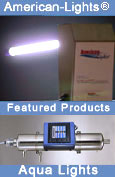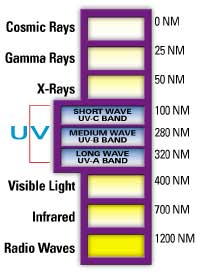Ultraviolet rays have shorter wavelengths than visible light. A wavelength, the distance between the crests of two waves, is often measured in units called nanometers. A nanometer (nm) is a billionth of a meter, or about 1/25,000,000 inch. Wavelengths of visible light range from about 400 to 700 nm. Ultraviolet wavelengths range from about 1 to 400 nm and are beyond the range of visible light.
Ultraviolet rays with wavelengths shorter than 300 nm are extremely effective in killing bacteria and viruses. The most effective sterilizing range for UV is within the C bandwidth
(UVC). This range is called the germicidal bandwidth. UVC has been used in hospitals for decades to sterilize surgical instruments, water, and the air in operating rooms. Many food and drug companies use germicidal lamps to disinfect various types of products and their containers.
The cleaning mechanism of UV is a photochemical process. The contaminants that pollute our homes are almost entirely based upon organic or carbon-based compounds. These compounds breakdown when exposed to high intensity UV at 240 to 290 nm. Short-wave ultraviolet light can destroy DNA in living microorganisms and breakdown organic material found in indoor air. UVCís effectiveness is directly related to intensity and exposure time.
UV rays must strike the contaminants directly in order to penetrate the microorganism and break down its molecular bonds. This bond breakage translates into cellular or genetic damage with the germs rendered harmless by robbing them of the ability to reproduce.
|
|
|




